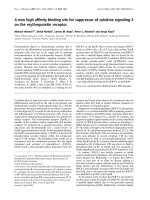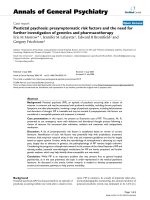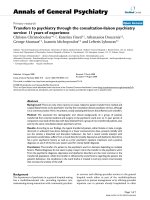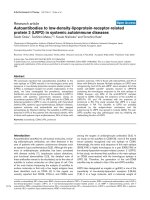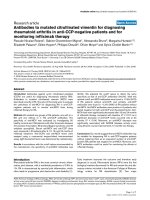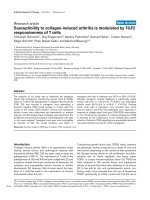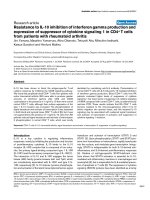Báo cáo y học: "Vulnerability to High Risk Sexual Behaviour (HRSB) Following Exposure to War Trauma as Seen in Post-Conflict Communities in Eastern Uganda: A Qualitative Study" pps
Bạn đang xem bản rút gọn của tài liệu. Xem và tải ngay bản đầy đủ của tài liệu tại đây (255.9 KB, 44 trang )
This Provisional PDF corresponds to the article as it appeared upon acceptance. Fully formatted
PDF and full text (HTML) versions will be made available soon.
Vulnerability to High Risk Sexual Behaviour (HRSB) Following Exposure to War
Trauma as Seen in Post-Conflict Communities in Eastern Uganda: A Qualitative
Study
Conflict and Health 2011, 5:22 doi:10.1186/1752-1505-5-22
Wilson WINSTONS Muhwezi ()
Eugene Kinyanda ()
Margaret Mungherera ()
Patrick Onyango ()
Emmanuel Ngabirano ()
Julius Muron ()
Johnson Kagugube ()
Rehema Kajungu ()
ISSN 1752-1505
Article type Research
Submission date 18 March 2011
Acceptance date 19 October 2011
Publication date 19 October 2011
Article URL />This peer-reviewed article was published immediately upon acceptance. It can be downloaded,
printed and distributed freely for any purposes (see copyright notice below).
Articles in Conflict and Health are listed in PubMed and archived at PubMed Central.
For information about publishing your research in Conflict and Health or any BioMed Central journal,
go to
/>For information about other BioMed Central publications go to
/>Conflict and Health
© 2011 Muhwezi et al. ; licensee BioMed Central Ltd.
This is an open access article distributed under the terms of the Creative Commons Attribution License ( />which permits unrestricted use, distribution, and reproduction in any medium, provided the original work is properly cited.
- 1 -
Vulnerability to High Risk Sexual Behaviour (HRSB)
Following Exposure to War Trauma as Seen in Post-
Conflict Communities in Eastern Uganda: A
Qualitative Study
Wilson Winstons Muhwezi
1§
, Eugene Kinyanda
2
*, Margaret Mungherera
1
*,
Patrick
Onyango
3
*, Emmanuel Ngabirano
3
*, Julius Muron
5
*, Johnson Kagugube
4
*, Rehema
Kajungu
3
*
Author Affiliations
1
Makerere University College of Health Sciences, School of Medicine, Department of
Psychiatry, P. O. Box 7072, Kampala, Uganda
2
Medical Research Council/Uganda Virus Research Institute (MRC/UVRI), P. O. Box
49, Entebbe, Uganda
3
Transcultural Psychosocial Organization Uganda (TPO-Uganda), Plot 3271
Kansanga off Ggaba Road, P.O. Box 21646 Kampala, Uganda, Email:
, Website: www.tpoug.org
4
Uganda Bureau of Statistics (UBOS), P.O. Box 7186, Kampala, Uganda
5
Butabika National Referral Mental Hospital, Plot 2, Block 237-238, Butabika Road,
Kampala, Uganda
*These authors contributed equally to this work
§
Corresponding author
Wilson Winstons Muhwezi, Makerere University College of Health Sciences,
School of Medicine, Department of Psychiatry, P. O Box 7072, Kampala, Uganda,
Email:
,
- 2 -
Email addresses:
WWM:
EK:
MM:
PO:
EN:
JM:
JK:
RK:
Abstract
Background
Much of the literature on the relationship between conflict-related trauma and high
risk sexual behaviour (HRSB) often focuses on refugees and not mass in-country
displaced people due to armed conflicts. There is paucity of research about contexts
underlying HRSB and HIV/AIDS in conflict and post-conflict communities in
Uganda. Understanding factors that underpin vulnerability to HRSB in post-conflict
communities is vital in designing HIV/AIDS prevention interventions. We explored
the socio-cultural factors, social interactions, socio-cultural practices, social norms
and social network structures that underlie war trauma and vulnerability to HRSB in a
post-conflict population.
- 3 -
Methods
We did a cross-sectional qualitative study of 3 sub-counties in Katakwi district and 1
in Amuria in Uganda between March and May 2009. We collected data using 8 FGDs,
32 key informant interviews and 16 in-depth interviews. We tape-recorded and
transcribed the data. We followed thematic analysis principles to manage, analyse and
interpret the data. We constantly identified and compared themes and sub-themes in
the dataset as we read the transcripts. We used illuminating verbatim quotations to
illustrate major findings.
Results
The commonly identified HRSB behaviours include; transactional sex, sexual
predation, multiple partners, early marriages and forced marriages. Breakdown of the
social structure due to conflict had resulted in economic destruction and a perceived
soaring of vulnerable people whose propensity to HRSB is high. Dishonour of sexual
sanctity through transactional sex and practices like incest mirrored the consequence
of exposure to conflict. HRSB was associated with concentration of people in camps
where idleness and unemployment were the norm. Reports of girls and women who
had been victims of rape and defilement by men with guns were common. Many
people were known to have started to display persistent worries, hopelessness, and
suicidal ideas and to abuse alcohol.
Conclusions
The study demonstrated that conflicts disrupt the socio-cultural set up of communities
and destroy sources of people’s livelihood. Post-conflict socio-economic
reconstruction needs to encompass programmes that restructure people’s morals and
values through counselling. HIV/AIDS prevention programming in post-conflict
- 4 -
communities should deal with socio-cultural disruptions that emerged during
conflicts. Some of the disruptions if not dealt with, could become normalized yet they
are predisposing factors to HRSB. Socio-economic vulnerability as a consequence of
conflict seemed to be associated with HRSB through alterations in sexual morality.
To pursue safer sexual health choices, people in post-conflict communities need life
skills.
- 5 -
Introduction
Globally, armed conflicts result in unprecedented waves of population displacement,
both within and across borders. Armed conflicts are associated with direct
consequences like deaths, diseases, stress, migration and environmental destruction;
indirect socio-economic disruption in the form of institutional, infrastructural and
human capital destruction; and opportunity costs like famine due to disruption of
agriculture as well as poverty due to disruption of commerce and education [1]. In
Uganda, large parts of the north and east of the country display signs of
impoverishment, possibly because of devastation associated with recent armed
conflict [2]. Out of an estimated total population of 30.7 million people, the 2009/10
Uganda national household survey estimated that by region, the poor in the north were
46.2% , 24.3% in the east, 21.8% in the west and 10.7% in the central [3].
Compared to other regions in Uganda, more people in the north and east of the
country were displaced from their homes and exposed to high risk sexual behaviours
(HRSB). Generally, displacement of people is associated with food insecurity, sexual
exploitation especially by men who wield some form of power (economic, physical
and social), gender-based sexual violence, idleness and drunkenness and
compromised resilience. Due to long stays in camps, avoidance of risky sexual
behaviour is more likely to be compromised. Other likely consequences of people’s
displacement include inadequacy of income and other basic needs, severe deprivation
leading to commercial sex work, chaotic circumstances in which access to condoms
and other preventive options may be scarce, and lack of health infrastructure and
education. These factors are known to expose people, especially women and children
to HRSB [4-7]. HIV/AIDS prevalence rates in conflict-affected areas of Uganda were
reported to be higher than the national average of 6.4% [7]. For instance, unlike in
- 6 -
other rural regions, the prevalence rate of HIV/AIDS in North Central Uganda
(Acholi, Teso, Lango) was found to be 8.2%, which is comparable to urbanized
Kampala and the Central region of 8.5% [5, 7, 8]. This could partly be explained by
the over 20 years of war between the Government of Uganda and the rebels of the
Lord’s Resistance Army (LRA).
The UNAIDS (Joint United Nations Programme on HIV/AIDS) Inter-Agency Task
Team on Gender and HIV/AIDS reports that 75% of the more than 35 million people
made refugees or displaced by conflict globally are women and children [9]. This
exposure to conflict and associated trauma is likely to be associated with HRSB [10,
11]. High risk sexual behaviour (HRSB) refers to any lifestyle or an activity that
places a person or people at an increased risk of suffering or getting infected with
HIV/AIDS, a sexually transmitted disease and/or an unwanted pregnancy. In this
article, HRSB was taken to include engaging in one, some or all the following
behaviours; extra marital sex, multiple sexual partners, cross-generational sex,
transactional sex, a high turnover of sexual partners, sex with uniformed personnel,
and unprotected sex with persons whose HIV sero-status is suspected to be positive
[12, 13].
In Sub-Saharan Africa, HRSB and violent conflicts are known to interact in shaping
population health in dramatic ways. HRSB may be created by conflict [14, 15]. HRSB
may also affect the epidemiology of HIV/AIDS [16, 17]. This is well explained by the
theoretical perspectives of ecological systems theory which explains human behaviour
in terms of forces at individual, social, political, cultural, and other levels and not
merely the level of individual psychology [18, 19]. The theory posits that
understanding the dynamics underlying any human behaviour requires an examination
- 7 -
of the social systems within which risky behaviour occurs and underscores the fact
that behaviour is influenced not only by the social context but also the social support
systems, level of conflict and social interactions. In Northern Uganda, a recent study
established that traditional social institutions that influence behaviour and regulate sex
were rendered dysfunctional by conflict and displacement, thereby paving way for
HRSB [5, 7].
Pervasive conflict and war often catalyze the disintegration of communities and
families as well as the disruption of social norms governing people’s sexual behaviour
[20]. Men who lose their status in their communities or families due to armed conflict
are more likely to resort to alcohol abuse and to engage in HRSB. Most women also
become vulnerable given their increased dependence on men for physical or economic
security. Since many displaced persons are forced to leave their homes, women may
be forced to trade sex with armed men or other people supposed to protect them in
exchange for food, water, shelter, protection and other basic commodities. Such
“survival sex” might involve sex with men infected with sexually transmitted
infections (STIs), including HIV. Women are also likely to suffer at the hands of boys
and young men who become child soldiers and are forced to become violent and
abusive as part of their training [9].
Globally, much of the literature about the relationship between conflict-related trauma
and HRSB is on refugees and not mass in-country displacement of people by ensuing
armed conflicts which is the focus of research for this article. Secondly, though a lot
of research in the area of HIV/AIDS in non-war affected communities in Uganda
abounds, there is little known about conflict and post-conflict communities.
Therefore, it was worth every effort to examine the interrelationship that may exist
- 8 -
between prolonged conflict and HRSB among the people of Teso sub-region in
Eastern Uganda.
Understanding factors underpinning vulnerability to HRSB in the various high-risk
populations is an important cog in the design of interventions for HIV/AIDS
prevention. Using a qualitative approach, this study investigated the dynamics
underlying vulnerability to HRSB following exposure to war trauma as seen in
Katakwi district, Eastern Uganda. Specifically, this article reports results of a study
that examined; (i) the interrelationship between vulnerability, exposure to war trauma
and HRSB and (ii) the socio-cultural dynamics that underlay risky sexual behaviours
in a post-conflict population.
Methods
Study Site and Context
The study was conducted in Teso sub-region districts of Katakwi and Amuria among
people who were the target of a community psychosocial intervention project
implemented by Transcultural Psychosocial Organization (TPO-Uganda) under the
auspices of Uganda AIDS Commission-Civil Society Fund. The main aim of the
project was to reduce the risk of HIV infection among war affected vulnerable groups.
This project was encouraging the uptake of HIV prevention measures. The TPO-
Uganda project had the following activities;
1. Screening for exposure to war trauma, psychological and gynaecological
effects of war trauma, membership to various vulnerability groupings, and
HRSB
- 9 -
2. Providing rehabilitation through community interventions like encouraging
membership to support groups, attending of community counselling programs,
psycho-education programs and general health education
3. Providing out reach medical services at health centres for people with more
severe forms of mental health and gynaecological problems (including STI)
as a consequence of war trauma, and
4. Providing a package of HIV prevention services like; HIV/AIDS voluntary
counselling and testing (VCT), health education about HIV/AIDS,
encouraging health seeking behaviour for sexually transmitted disease (STDs),
facilitating provision of services for STD treatment and life skills training for
in-school and out-of-school youths.
TPO-Uganda is a Non-Governmental Organization (NGO) that commenced
operations in Uganda in 1994 with the aim of providing psychosocial support and
mental health care to communities, families and individuals in conflict and post-
conflict settings. TPO-Uganda has projects in the West Nile, Northern and in Eastern
regions of Uganda.
The study participants were from 4 sub-counties, 3 in Katakwi district and 1 in
Amuria district. By 2010, the estimated population of Katakwi was 153,600 people
and 315,900 people in Amuria [21]. Media reports in Uganda suggested that by the
end of 2005, the prevalence of HIV/AIDS in Katakwi had increased from 9% to 21%
[22]. Secondly, anecdotal information from the district put the prevalence rate of
HIV/AIDS and Sexual Reproductive Health (SRH) problems at 17% [23]. However,
the total prevalence of HIV/AIDS in northeast Uganda where Katakwi and Amuria
are two of the 7 districts was put at 3.5% by a national survey [8]. The main ethnic
groups in the area are the Iteso and Kumam and the main language is Ateso.
- 10 -
Subsistence agriculture and pastoral animal husbandry are the two main economic
activities. The agricultural products are millet, sorghum, groundnuts, sim-sim, cow
peas, maize, soya beans, sweet potatoes, and vegetables. The main cash crop is cotton.
Though having tarmac roads, the two districts have mostly seasonal, dusty and pot-
holed roads and footpaths traversed mostly by motorcycles and bicycles.
Contextually, the conflict in the study area had existed in varying intensities and
intermittency from as far back as the 1950’s. The main players were: Karamonjog
cattle rustlers; Uganda People’s Army (UPA) who staged a rebellion against the
government from 1985 to 1992; Alice Lakwena’s spiritual/political rebellion of 1987-
1988; Lord’s Resistance Army (LRA) incursions in the Teso sub-region in 2002, 2004
and 2006; and government armed forces who participated in each of the conflicts by
trying to re-establish normalcy and liberate civilians [24-26]. By January 2010, about
200,000 people out of about 2 million who had been displaced in northern Uganda
and the Teso sub-region were still living in camps [27]. In the research for this article,
the opinion leaders, community members and guides from TPO-Uganda helped in
selection of potential participants.
Design of the Study
We used a cross-sectional qualitative approach to examine the dynamics that underlay
HRSB in trauma-affected populations and people’s perceptions, beliefs and
explanatory models. The approach is known to be good in understanding social
processes and concepts from the perspectives of study participants informed by their
lived experiences [28]. This qualitative study was part of the bigger study conducted
to assess vulnerability to HRSB following exposure to war trauma as seen in Eastern
Uganda.
- 11 -
Study Participants and Procedures
Data were concurrently collected between March and May 2009 from non-
probabilistic purposive samples of 32 key informants, 16 in-depth interviews and 8
FGDs who were equally spread in the study area. Selection of study participants was
done in such a way that it represented variation in the phenomenon of interest. The
various sources of data and number of study participants are summarized in Table 1.
All study participants had to be aged 15 years and above which is closer to 15.7 years,
the median age of sexual debut for females in East Central Uganda where Katakwi
and Amuria are found) [29]. They also had to be residents in the study area. To attain
theoretical sensitivity, heterogeneity of participants was ensured through adherence to
diversity in terms of age and gender differences of selected study participants.
Whereas the possibility of compromising data quality was high, this was anticipated
and forestalled during the planning process for fieldwork. The data collection tool was
pre-tested to ensure its appropriateness. The tool was originally formulated in English
but translated into Itesot, and blind back-translated into English to ensure conceptual
consistency and accuracy. Research assistants who spoke both languages translated
the guide from English to Itesot, and the other four assistants did the back-translation.
Before collecting any data, participants were told about the study purpose. Data was
collected and analyzed to a point where no more new information to enrich theme
identification was forthcoming [30]. Theme identification in the data started during
literature review and continued as long as patterns that captured interesting issues
were emerging [31, 32]. We started to notice and look for patterns of meaning and
issues of interest like the interface between civilians and the armed forces, parental
- 12 -
loss as a precursor to HRSB, food scarcity, changing socio-cultural configuration due
to conflict, poverty and transactional sex, cultural breakdown, fatalism, and learned
helplessness, and trauma-induced consequences as data collection progressed. The
process of data collection stopped when we began to notice repetition of
information—almost verbatim—from different study participants.
Focus Group Discussions (FGDs): Using open-ended questions, FGDs were
conducted with men alone and women alone in the age ranges of 15-24, 25-34 and >
35 years. Additional 2 groups were of in-school and out of school youths. The FGDs
were conducted at venues convenient to study participants, in Ateso, the local
language dialect. FGDs ensured collection of data on attitudes, perceptions, beliefs
and practices regarding vulnerability to HRSB following exposure to war trauma in
the study communities. The FGDs consisted of 7 to 12 participants and were useful in
eliciting rich data associated with peer interaction and debates.
Key Informant interviews (KIs): Key informants were expert sources of
information, who given their personal skills, or position within a society, were able to
provide more information and a deeper insight into what was going on around them.
They were the "natural observers" and were interested in the behaviour of those
around them. They could observe the development of their culture and make
inferences [33]. We used this method to collect data from elders, cultural leaders,
leadership of internally displaced peoples’ (IDP) camps and other opinion makers
like religions leaders, district political and civil leadership and civil society
organizations (CSO) workers in the study area. The purpose of these interviews was
to obtain in-depth information on the study phenomenon.
- 13 -
In-depth case study interviews: Sixteen case studies half of whom were coping with
war-related trauma rather poorly were purposively selected and engaged in in-depth
interviews. The case-studies were drawn from all the four study sub-counties and had
both male and female representation.
Data collection was based on appropriate interview guides based on a review of an
earlier version of the McGill Illness Narrative Interview (MINI) [34], field
experience, and research objectives. The first author developed the data collection
guides, each of which had a section consisting of some demographic profile,
vulnerability narrative, context of trauma and sexual behaviour, explanatory models
of sexual behaviour in a post-conflict setting, and impact of conflict-related trauma on
sexual behaviour as domains of inquiry shown in Table 2.
The research team discussed and reached a consensus on suitability of the questions
and pre-tested them on similar participants that were excluded from the final study.
Research assistants were trained on all aspects of qualitative research notably: how to
collect data, how to probe and paraphrase and ethical obligations in research. The
purpose of training was to ensure that they gained ability to get exhaustive and in-
depth data about study participants’ full stories regarding the sexual behaviour.
Each data collection session was tape-recorded after seeking permission of study
participants. Data was thereafter transcribed verbatim by a bilingual speaker
following acceptable guidelines [31]. All research assistants also took detailed field
notes. Data collection was overseen by a supervisor who coordinated four teams of
research assistants, each consisting of a moderator and a note taker. Each team was
- 14 -
assigned a sub-county. Each member of the research team was required to keenly
observe the context of the study population and note down salient features. This was
necessary to back-up and contextualize the data that was collected.
Ethical considerations
We obtained ethical and administrative clearances from the Uganda National Council
for Science and Technology Committee on the Study of Human Subjects, the
administrators of the study districts and the local community leaders. Study
participants gave verbal informed consent to be interviewed and we assured and
accorded them privacy, anonymity, and confidentiality. We told them of their liberty
to withhold information they were uncomfortable to give. We referred those who
asked questions requiring therapeutic answers to appropriate professionals for help.
Data analysis
Analysis and collection of data progressed simultaneously. Emerging themes and
impressions guided data collection. Words, content and context of what was said by
participants was analyzed to ‘get a mental picture’ of the interrelationship between
war-related trauma and HRSB. Data were analyzed and interpreted manually. The
Ateso audiotapes of all the data collection processes were transcribed following
standard guidelines [35, 36] into English, scrutinized, and categorized by a bilingual
speaker. Transcripts were reviewed and checked against original audio recordings by
a language expert to ensure translation accuracy. The transcribed data were compiled
into a text document. The first author closely read each transcript several times to get
familiar with the depth and breadth of the data content, inscribe notes on margins of
the data book, identify key words, search for more meanings and patterns, and write
detailed notes on emerging themes [31, 32].
- 15 -
Coding was approached, in part, with questions that inspired the study and also with
an expectation of coming across novel information. Through systematically working
through the whole data set, coding progressed from what was available at data
collection to assortment into identified patterns [31, 32]. After identifying several
codes, we matched them with comparable ‘chunks’ of data extracts. Examples of
codes identified included; ‘orphan-hood resulting from deaths associated with cattle
rustling activities and with HIV/AIDS’, ‘interaction between civilians and the
military’, ‘a socio-cultural environment associated with HRSB’, ‘a high population
density in IDP camps’, ‘transactional sex and HRSB’, ‘changes in sexual practices’,
‘cultural breakdown’, ‘alcohol abuse’, ‘early marriages’, ‘forced marriages’, ‘learned
helplessness’, ‘gender-based violence’ and many others. After generating a list of
codes and collating them with data extracts, they were sorted into potential sub-
themes and themes. Observed differences and similarities within the data aided in
assigning different data segments to different tentative themes.
Each extract of transcribed data was subjected to thematic analysis [37]. Through
constant comparison, emergent themes, sub-themes, and data extracts coded were
identified [31, 32, 38]. Some tentative themes could be accommodated in others while
others deserved to be broken down. Bearing in mind the objectives of the study,
theory and literature; data content, study context and underlying clusters of concepts,
and relationships between codes, themes, and different levels of themes were noted
[32]. Thereafter, more review and refinement was conducted to ensure coherent
patterns [31]. The final themes were; (i) breakdown of the social structure in the study
population, (ii) consequences of exposure to conflict on resilience, (iii) gender-based
abuse in a post-conflict setting and (iv) the relationship between exposure to
- 16 -
prolonged war trauma, well-being and HRB. These themes appeared to be linked to
HRSB and are discussed in the results section. We used illuminating verbatim
quotations from participants to illustrate major findings.
Results
In keeping with the ecological systems theory that looks at the influence of several
environmental systems on an individual [18], this study set out to explore the
relationship between conflict-related trauma and sexual behaviour of individuals
using a qualitative research design. Some of the study participants had left IDP camps
and resettled in their original villages. Others were still living in IDP camps. The
outcome of analysis and interpretation of findings are the social phenomena
summarised in the final themes.
Breakdown of the social structure in the study population
Data from case studies, FGDs or KIs demonstrated high levels of socio-economic and
cultural adversity that seemed to be related to vulnerability to HRSB. Reports from
study participants indicated that people in the study area had faced adversities ranging
from loss of livestock to cattle rustlers, food insecurity, forced soldiering, early
marriages, loss of livelihoods and overcrowded living arrangements in IDP camps
characterized by squalid living conditions, dysfunctional families and break down of
social ties.
Discrediting of sexual sanctity in society
Even after coming out of displacement that came about due to ensuing conflicts and
wars, most people in the study population were still mourning the loss of their
property which had always been a basis of their livelihood. Apparently, this had
- 17 -
forced some of them to adopt HRSBs to acquire basic necessities of life. With the
maltreatment of men during the conflicts who are traditional breadwinners, many
widows and vulnerable girls were reported to have ended up with no viable
alternatives of supporting their families. Engaging in transactional sex was reported to
have become a choice for many. Many of them took to engaging in HRSB to get
money to buy food or to get physical food from those privileged to control or own it.
Even after the ‘guns had fallen silent’ many widows and vulnerable girls were known
to have continued with the HRSB adopted during the time of active conflicts.
Findings from an FGD of 12 men aged 24-35 years and a 45 year old female who was
a case study showed that impoverishment associated with the conflict had increased
HRSB;
. . . with onset of the wars, things here changed . . . poverty increased,
insecurity became an issue and, we could not live freely like it was before.
Soldiers started to use money to lure young girls and women into sex . . .
HIV/AIDS became common here when soldiers were deployed to guard our
camp . . . many started sleeping with our daughters and wives . . . in our
communities, whenever a new person would arrive in a camp, women would
be easily enticed by him into sex . . .
. . . living in IDP camps affected us . . . our cultural values and norms lost
their sting . . . children stopped respecting their elders . . . they started sexual
acts early. In the crowded camps, children would see their parents in sexual
acts because the huts were too small for all family members . . . if a woman
failed to get something from a husband and someone else was there and
willing to do it in exchange for sex, she would go for it. This became common .
. . most men lost their wives and daughters to soldiers . . .
- 18 -
In the context of history and nature of the ensuing conflict, study participants
described the gradual disintegration that their lives took over a period of time. The
types of lifestyles which preceded the conflict were nostalgically described as having
been blissful and characterized by respect for elders and sexual sanctity. During the
course of the wars and conflict, factors that demeaned sexual sanctity like poverty,
concentration of many people in IDP camps, civilian-military interaction, and
transactional sex were thought to have become unrelenting as illustrated the words of
a 45 year old representative of a community based organisation (CBO) reproduced
below;
Ever since problems befell our community, people’s lives have been affected
negatively . . . spread of diseases like HIV/AIDS became rampant due to
crowding in IDP camps . . . the spread of HIV in this place started with
deployment of soldiers here. Soldiers took people’s wives since they had more
money . . . these women came back to their husbands with HIV.
Similar sentiments were affirmed by participants in a 9-member FGD of men aged
24-35 years. For some men, displacement into IDP camps had also meant loss of
power and ability to provide for their families. That is perhaps why some made
references to wives or daughters that were taken over by other men who had money
and influence.
It looks plausible that the civil conflict resulted in socio-economic and cultural
impoverishment with many implications on sexual behaviour. The post-conflict socio-
economic and cultural setting still had signs of living in conflict notably; food
insecurity, poor and overcrowded housing, learned helplessness, and apathy. A high
level of impoverishment is known to drive vulnerable groups in society, like women
- 19 -
into adopting HRSB like transactional sex in order to secure survival for either
themselves or their children. The destruction of means of livelihoods associated with
conflict had indeed pushed some women into HRSB in order to support themselves
and their families. According to an FGD of men aged 24-35 who were still in an IDP
camp, this had dire consequences on sexual behaviour;
. . . our lives here have become are characterised by difficulties . . . we cannot
cultivate easily as we used to . . . we lack what to eat . . . as a result of
overcrowding in the camp, evils like sexual immorality have spread . . . we
have very many cases of defilement, extra marital sex, early marriages and
forced marriages, many of which were unheard of in the past . . . because they
want to look smart and to have beautiful things, our girls and even women are
enticed by those with money into having sex. . .
Perceptions about sexual morality and decency
The exposure to conflict for a long time was believed to have had implications on
people’s sexual integrity as well as the timing of marriage. Although this exposure
was experienced by both women and men, women and adolescent girls appeared to
have faced the heaviest brunt of trauma associated with conflict. Men and women
believed that some of the socially nauseating sexual practices like incest had crept
into the current society due to alterations in the socio-cultural context. This sentiment
is well expressed by a 42-year old man in sub-county A, the FGD of men aged 24-35
years, and the FGD of women aged 24-35 years in that order;
So many things like incest, defilement, forced marriages and early marriage .
. . are rampant in our society. These things used to be rare in our society . . .
displacement by wars lead our people to learn strange behaviours . . . parents
have started forcing their daughters to marry early because they want money .
- 20 -
. . Young people got to know about sex very early in life . . . young girls and
boys learnt to go for old men and women simply because a young person
would take pride that a man or woman can provide for his or her needs
. . . our neighbouring community of cattle rustlers led to many deaths and
forced us into IDP camps. These neighbours are partly responsible for today’s
forced marriages and other sexual immoralities in our area . . . If they had not
forced us into camps, sexual immorality, infidelity, defilement and rape
wouldn’t have become common here . . . nowadays, people force their sons to
get married early before the raiders come to steal the cattle. Secondly, parents
force their daughters to marry such that they can get replacement of the stolen
cattle.
. . . sex is being misused, it is an embarrassment to the society . . . young men
nowadays go into sexual relationship with their mothers’ age-mates, girls
have started to have sex with old men. Sex has been commercialized . . . It has
become worse with the worsening economic turmoil where everything needs
money. Unwanted pregnancies have become common and so are abortions
Transactional sex in the context of vulnerability
At the peak of the conflict, the level of interaction between civilians in the study area
and newcomers like military personnel and aid workers was reported to have been
high. This happened in a population with many orphans and other vulnerable groups
of people who had been created by adversities associated with cattle raids, abductions
and murders. Other than adults who engage in transactional sex due to economic
challenges, orphans especially of the female sex in the emerging individual-centred
- 21 -
study population are known to end up in HRSB like prostitution and early marriages
because of societal neglect. The views of a 49-year camp leader who was an elder
and the FGD of younger men aged 15 to 24 years respectively illustrate the assertion
above;
. . . we have people living with HIV and different kinds of orphans . . . for
some, one of the parents is dead while for others, both are dead . . . this is a
problem . . . most of the girls who are orphans go for early marriages so as to
be able to support their siblings . . .
. . . life in IDP camps has really doomed us . . . because of behaviour adopted
while in camps, sex has ceased to be respected . . . Sexual encounters now
happen anywhere i.e. in pit latrines, bathrooms and even in open places giving
children the opportunity to watch and thus get motivated to try doing it too. . .
married women cannot afford basic needs for their children . . .in IDP camps,
they learnt that they can survive if they get fairly rich men to have sex with in
exchange for the basic provisions of life, thus increasing the risk of acquiring
or spreading HIV . . . young girls learnt to be in love with elderly men for
benefits like school fees, food at home and scholastic materials.
Consequences of exposure to conflict on resilience
Due to life adversity associated with conflict, some of the initially resilient people
ultimately succumbed to engaging in HRSB. The words of a 40-year old man from
sub-county B reproduced below illustrate how most men were forced into life
trajectories known to be associated with engaging in HRSB.
. . . in October 1987, the cattle rustlers killed my father . . . . I dropped out of
school. . . . In 1990, we were hit by famine and our mother abandoned us . . . I
- 22 -
struggled to bring up my siblings since I was the first born. I married early
because I needed someone to help me take care of my siblings . . . In 1996, I
joined the army but the pay was not good and I used to be transferred quite a
lot. I stopped soldiering when my two brothers were in secondary school. In
2005, I tested HIV positive and . . . I started septrin prophylaxis. I have since
had other confirmatory HIV and Tuberculosis (TB) tests . . .
A number of social ills like; apathy to work, thinking about committing suicide, and
land conflicts were common in the study population and looked to have been
associated with exposure to traumatic conflicts. The effect of different people coming
to live together in IDP camps where there was little or no work seemed to have
cultivated learned helplessness and laziness. Redundancy undermined resilience and
predisposed people to substance and alcohol abuse and indulging in HRSB as
illustrated by the words of a 65 year old community based organization (CBO)
representative;
HIV might have not spread widely as it is nowadays . . . if it was not because
of displacement. People would have been in their traditional homes . . . the
laziness common in our people is linked to what happened to them . . . there
was too much idleness and taking alcohol . . . insecurity made it hard to go
back to villages to dig . . .
Concentration of many people in IDP camps was associated with too much idleness.
The only pastime for most of the men that were idle in IDP camps was alcohol
consumption. Alcohol consumption is known to compromise decision-making which
goes hand-in-hand with engaging in HRSB like casual sex. This issue is well captured
in the words of a village chairperson in sub-county D;
- 23 -
The lifestyle in IDP camps encouraged over drinking alcohol and engaging in
HRSB. People would take advantage of making others drunk to have sex with
them . . .
Gender-based abuse in a post-conflict setting
Women and girls were more likely to be victims of sexual abuse associated with the
war and conflict. Reports of girls and women that had been victims of rape and
defilement at the hands of rebel fighters and cattle rustlers were common as illustrated
by a quotation from a FGD of younger men aged 15 to 24 years from sub-county A;
. . . seeing one’s own mother or sister being raped, murdered and starved was
too painful . . . The LRA brutally murdered, looted and abducted children and
adults, some of whom have never returned . . .
Similar sentiments were expressed by the FGD of younger women from the same age
range and sub-county;
“. . . the violent approach of the conflict involved raping women and girls and
this left many of the victims feeling psychological pain and disgust with their
lives . . .”
Similarly, the FGD of women aged 35 years and above from sub-county D shared the
same perspective as illustrated below;
. . . innocent people were killed and this left many of them puzzled and
confused. Some women and girls were raped and this affected them
psychologically and in general health . . . some got infected with diseases they
did not have before . . .
Vulnerability to HRSB during war and the belligerent conflict appeared to have been
closely knit with role expectations of men, women and children in a home. Women
- 24 -
were reported to have persevered in their primary care-giving roles for a decent
survival during war even in situations of diminished life opportunities. While
pursuing these roles, some women and girls were reported to have ended up engaging
in HRSB so as to acquire resources to support either their families or themselves.
Some women and girls in the study population were reported to have engaged in
HRSB in exchange for food, money, clothes, cosmetics, and other survival
requirements. Since some women had no alternatives of meeting their basic needs and
those of their families during the intense conflicts, they engaged in HRSB as
illustrated by the words of a 50 year old CBO representative from sub-county B, a 49
year old camp leader from sub-county A and a 72 year old elder from sub-county C in
that order;
. . . Sex totally lost meaning . . . women started to have sex for material gain
and to support their families. . . poverty drove people crazy at the peak of war
here! . . . you would find some one giving in to have sex because she wanted to
earn a living . . . IDP camp life made the situation worse . . .
. . . all the deviance in sexual behaviour mainly resulted from difficulties that
people faced at the peak of war . . . there was food shortage and women
started to exchange sex for food, gifts and other valuables. Girls started to be
prematurely given out for marriage because of poverty . . . orphaned teenage
girls started to just give in to marriage as the only way to have a house. . .
Due to having just come out of a war situation, people generally feel dejected
and hopeless, others feel they are the unluckiest in the world . . . some see no
reason to live on . . . many women now exchange sex for food and other
